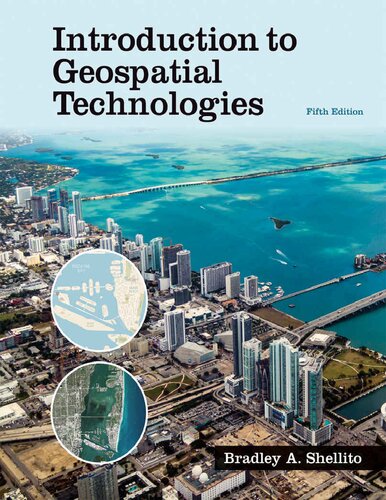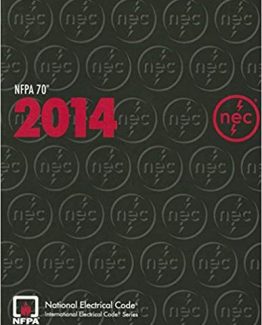Introduction to Geospatial Technologies 5th Edition by Bradley A. Shellito, ISBN-13: 978-1319249519
[PDF eBook eTextbook]
- Publisher: W. H. Freeman; Fifth edition (December 20, 2019)
- Language: English
- ISBN-10: 1319249515
- ISBN-13: 978-1319249519
Written for majors and non-majors alike, Introduction to Geospatial Technologies demonstrates the wide range of geographic technologies available to and used by geographers today. Each chapter contains an introduction to the key concepts and a lab activity, so that in addition to gaining a basic foundation of knowledge, students also obtain hands-on experience with the relevant software.
Table of Contents:
PART 1 Geospatial Data and GPS
CHAPTER 1 It’s a Geospatial World Out There
An Introduction to Geospatial Technologies, Geospatial Jobs,
Geospatial Data, Volunteered Geographic Information,
Geolocation, and Google Earth
What Is Geospatial Technology?
Who Uses Geospatial Technology?
What Is Geospatial Data?
What Does All This Have to Do with Geography?
What Is Geolocation?
What Is Google Earth?
Geospatial Lab Application 1.1: Introduction to
Geospatial Concepts and Google Earth Pro
Thinking Critically with Geospatial Technology
1.1 What Happens to Privacy in a Geospatial World?
Hands-On Application
1.1 Industries Using Geospatial Technology
1.2 Jobs in the Geospatial Field
1.3 The National Map
1.4 Mapping Data Layers Online
1.5 Examining Real Estate Values Online
1.6 Geospatial Technology and Crime Mapping
1.7 The Geospatial Revolution Will Be Televised
1.8 User-Generated Geospatial Content Online
1.9 Where Am I Right Now?
Geospatial Apps
Geospatial Technologies in Social Media
CHAPTER 2 Where in the Geospatial World Are You?
Locations in a Digital World, Position Measurements,
Datums, Coordinate Systems, GCS, Map Projections, UTM,
and SPCS
What Is a Datum?
What Is a Geographic Coordinate System?
How Can Real-World Data Be Translated onto a Two-
Dimensional Surface?
What Is UTM?
What Is SPCS?
Geospatial Lab Application 2.1: Coordinates and Position
Measurements
Thinking Critically with Geospatial Technology
2.1 Do You Really Need Printed Maps in a Digital World?
Hands-On Application
2.1 Replacing the NAD83 Datum
2.2 Great Circle Distance Calculations
2.3 Examining the Effects of Different Map Projections
2.4 Converting from Latitude/Longitude to UTM
2.5 Using the State Plane Coordinate System
Projection and Coordinate System Apps
Coordinate Systems and Projections in Social Media
CHAPTER 3 Getting Your Data to Match the Map
Reprojecting, Georeferencing, Control Points, and
Transformations
How Can You Align Different Geospatial Datasets to
Work Together?
What Is Georeferencing?
How Can Data Be Georeferenced?
How Is Data Transformed to a Georeferenced Format?
Geospatial Lab Application 3.1: Georeferencing an Image
Thinking Critically with Geospatial Technology
3.1 What Happens When Measurements Don’t Match Up?
3.2 What Happens When the Georeferencing Is Wrong?
Hands-On Application
3.1 David Rumsey Historical Map Collection
3.2 Online Georeferencing Resources
3.3 Georeferenced Historical Maps and the Spyglass
Georeferencing Apps
Georeferencing in Social Media
CHAPTER 4 Finding Your Location with the Global
Positioning System
GPS Origins, Position Measurement, Errors, Accuracy, GNSS
around the World, Applications, and Geocaching
Who Made GPS?
What Does the Global Positioning System Consist of?
How Does GPS Find Your Position?
Why Isn’t GPS Perfectly Accurate?
How Can You Get Better Accuracy from GPS?
What Other GNSS Are There Beyond GPS?
What Are Some Applications of GPS?
Geospatial Lab Application 4.1: GNSS Applications
Thinking Critically with Geospatial Technology
4.1 What Happens if GPS Stops Working?
Hands-On Application
4.1 Trilateration Concepts
4.2 Things to Do Before You Go Geocaching
GPS Apps
GPS and GNSS in Social Media
PART 2 Geographic Information Systems
CHAPTER 5 Working with Digital Geospatial Data and GIS
Geographic Information Systems, Modeling the Real World,
Vector Data and Raster Data, Attribute Data, Joining Tables,
Metadata, Esri, ArcGIS, and QGIS
How Does GIS Represent Real-World Items?
How Can You Represent the Real World as Continuous
Fields?
How Is Non-Spatial Data Handled by GIS?
What Other Kind of Information Do You Need to Use GIS
Data?
What Kinds of GIS Are Available?
Geospatial Lab Application 5.1: GIS Introduction: QGIS
Version
Geospatial Lab Application 5.2: GIS Introduction:
ArcGIS Pro Version
Thinking Critically with Geospatial Technology
5.1 What Happens When You Don’t Have Metadata?
Hands-On Application
5.1 Using GIS Online
5.2 GIS City Maps and Apps
5.3 The National Map Advanced Viewer
5.4 Esri News and Videos
GIS Apps
GIS in Social Media
CHAPTER 6 Using GIS for Spatial Analysis
Database Query and Selection, Buffers, Overlay Operations,
Geoprocessing Concepts, and Modeling with GIS
How Can Data Be Retrieved from a GIS for Analysis?
How Can You Perform Basic Spatial Analysis in GIS?
How Can Multiple Types of Spatial Analysis Operations
Be Performed in GIS?
Geospatial Lab Application 6.1: GIS Spatial Analysis:
QGIS Version
Geospatial Lab Application 6.2: GIS Spatial Analysis:
ArcGIS Pro Version
Thinking Critically with Geospatial Technology
6.1 What Are Potential Societal or Policy Impacts of GIS
Models?
Hands-On Application
6.1 Building SQL Queries in GIS
6.2 Working with Buffers in GIS
6.3 The Land Transformation Model
Spatial Analysis Apps
Spatial Analysis in Social Media
CHAPTER 7 Using GIS to Make a Map
Scale, Map Elements, Map Layouts, Type, Thematic Maps,
Data Classification Methods, Color Choices, and Digital Map
Distribution Formats
How Does the Scale of the Data Affect the Map (and Vice
Versa)?
What Are Some Design Elements Included in Maps?
How Is Data Displayed on a GIS Map?
What Kinds of Colors Are Best to Use with GIS Maps?
How Can GIS Maps Be Exported and Distributed?
Geospatial Lab Application 7.1: GIS Layouts: QGIS
Version
Geospatial Lab Application 7.2: GIS Layouts: ArcGIS
Pro Version
Thinking Critically with Geospatial Technology
7.1 Why Is Map Design Important?
Hands-On Application
7.1 Powers of 10—A Demonstration of Scale
7.2 Presidential Election Thematic Maps
7.3 The Census Data Mapper
7.4 ColorBrewer Online
Cartography Apps
Cartography in Social Media
CHAPTER 8 Getting There More Quickly with Geospatial
Technology
Satellite Navigation Systems, Road Maps in a Digital World,
Creating a Street Network, Geocoding, Shortest Paths, and
Street Networks Online
How Do You Model a Network for Geospatial
Technology?
How Is Address Matching Performed?
How Are Shortest Paths Found?
How Are Networks Used in Geospatial Technology?
Geospatial Lab Application 8.1: Geocoding and Shortest
Path Analysis
Thinking Critically with Geospatial Technology
8.1 What Happens When Maps Are Incorrect?
8.2 What Security, Privacy, and Other Issues Does Google
Street View Entail?
Hands-On Application
8.1 The U.S. Census TIGERweb
8.2 Geocoding Using Online Resources
8.3 Online Mapping and Routing Applications and Shortest
Paths
8.4 Finding the Best Route for Multiple Stops
8.5 Examining Google Street View
Geocoding and Shortest Path Apps
Geocoding and Shortest Paths in Social Media
PART 3 Remote Sensing
CHAPTER 9 Remotely Sensed Images from Above
Where Aerial Photography Came from, UAS, Color-Infrared
Photos, Orthophotos, Oblique Photos, Visual Image
Interpretation, and Photogrammetric Measurements
How Did Aircraft Photography Develop?
What Are Unmanned Aircraft Systems?
What Are the Different Types of Aerial Photos?
How Can You Interpret Objects in an Aerial Image?
How Can You Make Measurements from an Aerial
Photo?
Geospatial Lab Application 9.1: Visual Imagery
Interpretation
Thinking Critically with Geospatial Technology
9.1 What Is the Difference between Flying a UAS for
Commercial Purposes and for Recreational Purposes?
Hands-On Application
9.1 World War II Aerial Photography Online
9.2 No-Fly Zones for UAS
9.3 Viewing Aerial Photography Online
9.4 Examining CIR Photos
9.5 Oblique Imagery on Bing Maps
UAS Apps
Aerial Imagery in Social Media
CHAPTER 10 How Remote Sensing Works
Electromagnetic Energy, the Remote Sensing Process,
Spectral Reflectance, NDVI, Digital Imagery, and Color
Composites
What Is Remote Sensing Actually Sensing?
What Is the Role of the Atmosphere in Remote Sensing?
What Happens to Energy When It Hits a Target on the
Ground?
How Can Spectral Reflectance Be Used in Remote
Sensing?
How Do You Display a Digital Remotely Sensed Image?
Geospatial Lab Application 10.1: Remotely Sensed
Imagery and Color Composites
Thinking Critically with Geospatial Technology
10.1 How Does Remote Sensing Affect Your Privacy?
Hands-On Application
10.1 Viewing Remotely Sensed Imagery Online
10.2 Viewing Imagery over Time
10.3 Wavelengths and the Scale of the Universe
10.4 Color Tools Online: Color Mixing
10.5 Comparing True Color and False Color Composites
Remote Sensing Apps
Remote Sensing in Social Media
CHAPTER 11 Images from Space
Satellite Remote Sensing, Satellite Orbits, Sensor
Resolutions, the Landsat Program, High-Resolution Satellite
Sensors, Small Satellites, CubeSats, and Using Satellites for
Monitoring
How Do Remote Sensing Satellites Collect Data?
What Are the Capabilities of a Satellite Sensor?
What Is a Landsat Satellite, and What Does It Do?
What Satellites Have High-Resolution Sensors?
How Can Satellites Be Used for Monitoring Earth?
Geospatial Lab Application 11.1: Landsat 8 Imagery
Thinking Critically with Geospatial Technology
11.1 What Effect Does Satellite Remote Sensing Have on
Political Borders?
11.2 What Happens If Landsat Imagery Is No Longer Free to
Use?
Hands-On Application
11.1 Examining Satellite Orbits in Real Time
11.2 Viewing Landsat Imagery with LandsatLook Viewer
11.3 Google Earth Engine and Applications of Landsat
Imagery
11.4 Viewing Sentinel-2 Imagery Online
11.5 Viewing High-Resolution Satellite Imagery
11.6 Crowdsourcing Satellite Imagery
Satellite Imagery Apps
Satellite Imagery in Social Media
CHAPTER 12 Studying Earth’s Climate and Environment
from Space
NASA and NOAA Satellites, MODIS, VIIRS, LST, SST,
CERES, AIRS, OMI, OMPS, GRACE-FO, and Jason-3
What Satellites and Sensors Are Used for Studying
Climate and the Environment?
How Is Environmental Monitoring Performed Using
Remote Sensing?
How Do Satellites Take Earth’s Temperature?
How Do Satellites Monitor Earth’s Atmosphere and Air
Quality?
How Do Satellites Monitor the Oceans and Water
Quality?
Geospatial Lab Application 12.1: Earth-Observing
Missions Imagery
Thinking Critically with Geospatial Technology
12.1 What If We Lose the Capability for Large- Scale
Studying and Monitoring of Earth’s Climate and
Environment?
Hands-On Application
12.1 NASA’s Earth Observatory
12.2 NASA Eyes on the Earth
12.3 NASA Worldview
12.4 The VIIRS View Spinning Marble
12.5 NASA Global Maps
12.6 Examining the State of the Ocean
Earth-Observing Mission Apps
Earth-Observing Missions in Social Media
PART 4 Geospatial Applications
CHAPTER 13 Digital Landscaping
Modeling, Digital Elevation Models (DEMs), Lidar, 3DEP,
and Applications of Terrain Data
How Can Terrain Be Represented Using Contours and
Topographic Maps?
How Can Geospatial Technology Represent a Terrain?
What Is a DEM?
How Can Digital Terrain Models Be Utilized?
Geospatial Lab Application 13.1: Digital Terrain Analysis
Thinking Critically with Geospatial Technology
13.1 If Everything’s Digital, Do We Still Need Printed
Topographic Maps?
Hands-On Application
13.1 The Historical Topographic Map Explorer
13.2 US Topos as GeoPDFs
13.3 U.S. Elevation Data and The National Map
13.4 Terrain and Imagery Examples in Google Earth
Terrain and Topography Apps
Digital Terrain in Social Media
CHAPTER 14 See the World in 3D
3D Geovisualization, 3D Modeling and Design, Extrusion,
3D Imagery from Aerial Photography, Stereo Imagery in 3D,
VR, AR, and MR
How Can Objects Be Modeled in 3D Using Geospatial
Technology?
How Can Large-Scale 3D Design Be Performed?
How Can You View Geospatial Data in Immersive 3D?
Geospatial Lab Application 14.1: 3D Modeling and
Visualization
Thinking Critically with Geospatial Technology
14.1 What Is the Advantage of Using 3D Design?
Hands-On Application
14.1 SketchUp Free
14.2 Cesium and 3D Maps
14.3 3D Buildings and Structures in Google Earth
14.4 3D CityEngine Web Scenes
14.5 VR Google Earth
3D Visualization Apps
3D Visualization in Social Media
CHAPTER 15 Life in the Geospatial Cloud and Other
Current Developments
Using the Cloud with Geospatial Technology, Web Maps,
ArcGIS Online, Story Maps, Who’s Involved with Geospatial
Technology, Geospatial Technologies in K–12 Education, and
College and University Geospatial Educational Programs
How Is the Cloud Used with Geospatial Technology?
What Is ArcGIS Online?
Who Is Involved with Geospatial Technology?
How Is Geospatial Technology Used in K–12 Educational
Efforts?
What Types of Educational Opportunities Are Available
with Geospatial Technology?
Geospatial Lab Application 15.1: Creating Web Maps and
Web Apps with ArcGIS Online
Thinking Critically with Geospatial Technology
15.1 Who Owns Geospatial Data?
15.2 What’s Next for Geospatial Technologies?
Hands-On Application
15.1 The Living Atlas of the World
15.2 Esri Story Maps
15.3 AmericaView and the StateView Programs
15.4 Educational Resources and Lesson Plans
15.5 Degree Programs and Certificates for Geospatial
Technology
Geospatial Cloud and Organizational Apps
Geospatial Organizations and the Geospatial Cloud in
Social Media
Glossary
Index
Bradley A. Shellito is a geographer whose work focuses on the application of geospatial technologies. Dr. Shellito has been a professor at Youngstown State University (YSU) since 2004, and was previously a faculty member at Old Dominion University. He teaches classes in GIS, Remote Sensing, GPS, and 3D Visualization and his research interests involve using these concepts with a variety of real-world issues. He also serves as YSU’s PI in OhioView, a statewide geospatial consortium. A native of the Youngstown area, Dr. Shellito received his bachelor’s degree from YSU, his Masters from the Ohio State University, and his doctorate from Michigan State University.
What makes us different?
• Instant Download
• Always Competitive Pricing
• 100% Privacy
• FREE Sample Available
• 24-7 LIVE Customer Support






Reviews
There are no reviews yet.